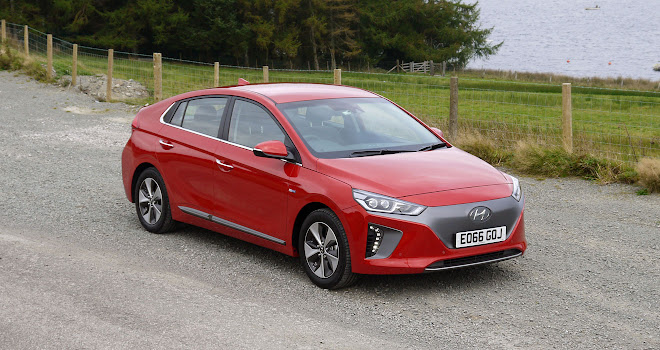
Rating: stars
Good: 100-mile-plus range, tidy handling, rapid charging support
Bad: small boot, questionable styling
Price: from £24,495 including grant
Hyundai’s new Ioniq is destined to be offered in three varieties: electric, hybrid and plug-in hybrid. The first two go on sale in the UK this month while the plug-in edition is not due until spring next year.
All three Ioniqs look very similar from the outside but you can easily spot the EV by its smoother snout. With no combustion engine to keep cool it has no need of grille slots above the number plate.
The result is not the prettiest nose ever seen on a car, while the big expanse of pale grey plastic makes the Ioniq EV quite colour sensitive too.
Painted white, for example, the electric Hyundai looks sleek and cool, like a giant Apple mouse. In the metallic brick red pictured, however, the front looks as if it’s still wearing protective packaging.
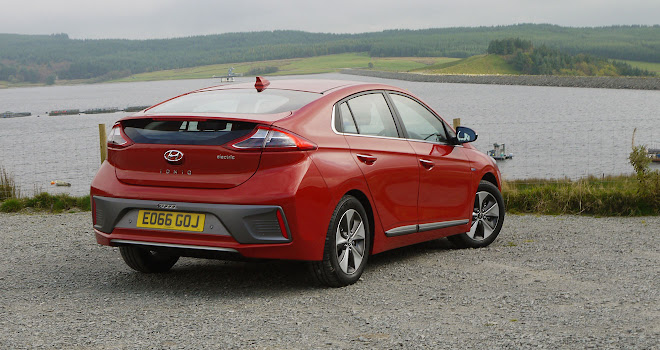
The styling is less outlandish than some alternatives such as the Nissan Leaf and BMW i3, though not as reserved (nor or as crisply cut) as the Volkswagen e-Golf.
The Ioniq’s overall shape is very hybrid-like, strongly reminiscent of the recently departed Honda Insight or third-generation Toyota Prius, right down to the split rear window. The horizontal divide does compromise rear vision somewhat, and there’s no wiper on either section, though with a standard-fit reversing camera this is less of an issue than it might otherwise be.
No doubt the Ioniq’s shape is aerodynamically efficient. Other, less obvious tweaks for the sake of efficiency include plastic inserts between the spokes of the alloy wheels, creating a smoother surface without much extra weight, and vertical slots in the front bumper that create an “air curtain” to help reduce turbulence from the spinning front wheel.

Hyundai also says it has used high-strength steel for the structure, plus aluminium for bonnet and tailgate, to keep bloat at bay. With a kerb weight of 1,420kg to 1,475kg depending on specification the Ioniq EV seems fairly lean compared to Nissan’s Leaf, which weighs about 55kg more across roughly equivalent trim levels.
Under its skin the Ioniq Electric has a 28kWh lithium-ion battery housed below the rear seats and under the boot floor. This means that while the hybrid Ioniq has space for a spare wheel, the electric version must make do with an emergency inflator.
The battery is actively air cooled and provides an official range of 174 miles. It’s probably more indicative to note that a fully charged car will show about 135 miles on its range predictor before you set off. The satnav screen will also helpfully plot how far you can travel on the current state of charge as a circle overlaid on the satnav map, though this view doesn’t adjust range in different directions according to the type of road, as found in some other EVs such as the VW e-Up and BMW i3.
Actual range will depend on how fast and how aggressively you drive, and whether you use the cabin heater or can make do with heated seats (and the warm steering wheel fitted to the top trim level).
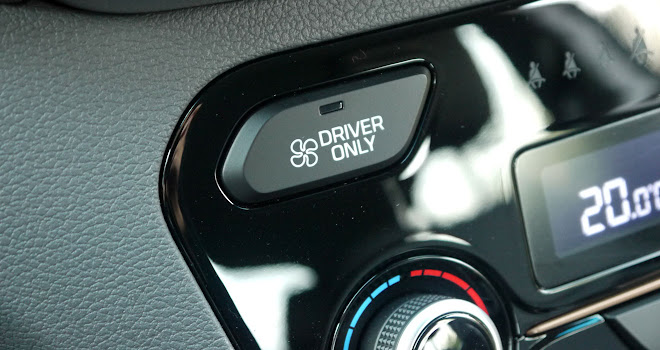
There is also, helpfully, a driver-only heating option that tames the energy drawn from the battery to keep you toasty while driving alone.
Recharging the battery from empty will take about 10 to 12 hours from a domestic three-pin plug, or 4 to 6 hours using a wallbox or fast public charger. On longer journeys, a CCS 50kW rapid charger can deliver an 80% top-up in around 33 minutes.
The charging socket is positioned on the nearside rear flank, which often proves to be a better place than the car’s nose when charging on a driveway, for example, if you aim to avoid backing onto the street.
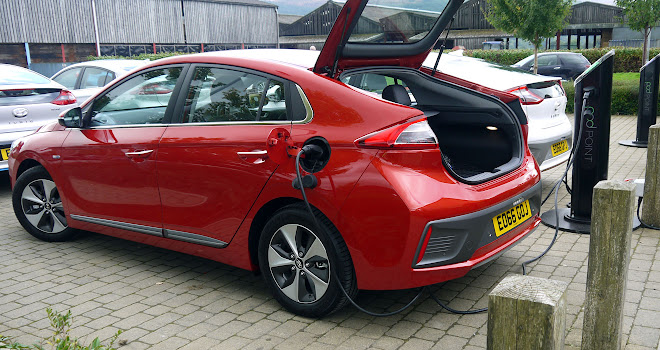
Inside, the Ioniq looks smart and modern, with pleasantly finished plastics. There are plenty of places to store oddments, including a good sized glovebox, deep armrest cubby and a useful tray in front of the centre console. A wireless phone-charging receptacle is also offered.
It’s relatively easy to get comfortable behind the wheel, with plenty of seat and wheel adjustment.

A seven-inch digital instrument panel is a standard fitment, as is an eight-inch central touchscreen with satnav. Despite the touchscreen, heating and ventilation controls are overseen using traditional buttons and knobs.
The electric Ioniq has no gearbox as such, with just one fixed forward ratio, and so has no real need of a gearstick. You select between neutral, park, drive and reverse using a cluster of four push-buttons on the centre console. This area also offers up an electronic handbrake flap with auto-hold option, as well as a driving mode switch.

There are three modes to choose among – normal, sport and eco – and pressing the mode button cycles through all three in that order. That means, with a bit of practice, you can flip from normal to sport with one key press and without moving your eyes from the road, which may prove handy for overtaking.
The three modes make quite a bit of difference to the way the car responds to the throttle, feeling much more frisky or decidedly lethargic either side of normal mode. The car has also been set up with quite a firm false floor in the accelerator pedal travel. You have to press through it to unlock the final quarter of the car’s potential.
Not initially realising that this kink existed, I thought the Ioniq Electric was a bit slow. It’s not: prod the throttle properly and the car will reach 62mph in 9.9 seconds in sport mode, or 10.2 seconds in normal mode. Drive is sent to the front wheels by an electric motor with power and torque ratings of 88kW (118bhp) and 218Nm.

The Ioniq Electric handles extremely well through corners, with unexpected levels of grip from its 16-inch, Michelin energy-saver tyres. The handling is also surprisingly adept given that Hyundai has fitted relatively crude rear suspension to free up space for the rear-mounted battery. The low-mounted weight of the battery presumably helps provide the car’s sure-footed feel.
Paddles behind the wheel allow full control over the battery regeneration level felt as you lift off the throttle. There are four settings from gliding with zero regeneration through to the equivalent of quite firm braking. The more aggressive levels will trigger the braking lights and the top setting allows one-pedal driving, where you will rarely need to use the brake pedal except for drawing to a complete stop or in an emergency.
The brake pedal has been set up with a very gentle initial feel. This is presumably to discourage sharp braking, which tends not to be energy efficient, but the result can be alarming if you’re not expecting it. Give the pedal a proper stomp, however, and the Ioniq Electric will stop smartly enough.
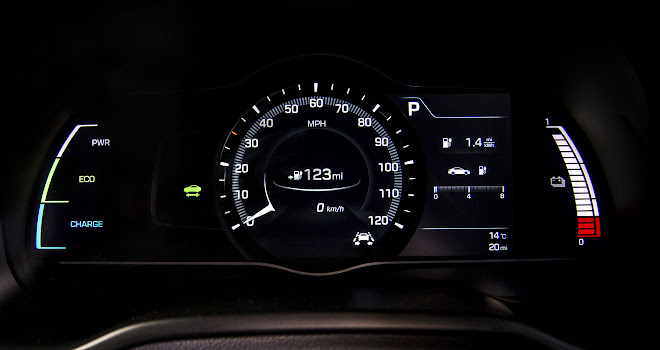
The instrument panel reconfigures when the car is put into sport mode, to show what percentage of full power you’re using. A permanent gauge to the left of the instrument panel also swings between power, eco and charging segments, providing a guide to efficient acceleration and braking, while an area to the right can be configured to show a variety of different things including satnav directions or energy flows from battery to wheels.
Prices start at £24,495 (including plug-in car grant of £4,500) for the Premium trim level, while another £1,800 buys the top Premium SE edition. Standard equipment is pretty generous with both versions offering LED lights all round, adaptive cruise control, reversing camera, satnav, keyless entry, heated seats, efficient heat-pump heating and rapid charging support. These things considered, the Hyundai seems very reasonably priced compared to a 30kWh Leaf.

Overall, the new Hyundai Electric ranks among the best electric cars currently available in its price bracket, with a real world-range from its 28kWh battery that should comfortably reach 100 miles for most drivers and could stretch as far as 130 miles with a little care.
Whether that is far enough is another question. With Renault having just announced a 41kWh Zoe, with a claimed real-world range of at least 186 miles, and Opel’s Ampera-E aiming to regularly exceed 200 miles between charges, the era of the 100-mile EV might soon be drawing to a close.
Zoe’s leap in range came about primarily as a result of improved cells from Renault’s Korean supplier, LG Chem. The same company provides cells for the Ioniq Electric, so perhaps a hike in capacity for the Hyundai lies in the not too distant future.
